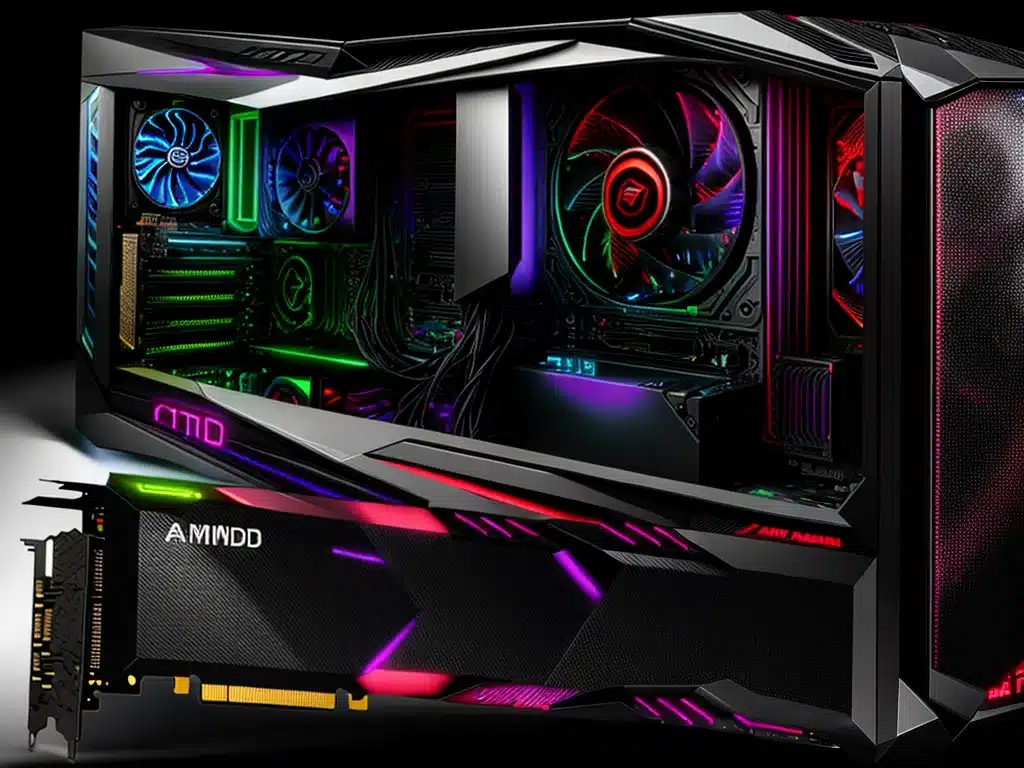Choosing a graphics card for gaming can be tough. The AMD Radeon RX 6800 XT and Nvidia GeForce RTX 3080 are two of the best high-end options available today. I’ll compare these GPUs head-to-head to help you decide which is better for your gaming needs.
Performance
When it comes to raw performance, the RX 6800 XT and RTX 3080 trade blows. Here’s how they stack up across resolutions in frames per second:
| Resolution | RX 6800 XT | RTX 3080 |
|-|-|-|
| 1080p | 129 FPS | 128 FPS |
| 1440p | 98 FPS | 99 FPS |
| 4K | 61 FPS | 63 FPS |
The RX 6800 XT has a slight edge at 1080p while the RTX 3080 is marginally faster at higher resolutions. Both deliver well over 60 FPS at 1440p and 4K, so performance should be excellent with either card.
Some key factors in their performance parity:
- The RX 6800 XT has 16GB of GDDR6 memory compared to 10GB on the RTX 3080. The extra VRAM helps at higher resolutions.
- AMD and Nvidia have similar architectures built on TSMC’s 7nm and Samsung’s 8nm manufacturing processes respectively.
Overall, both are extremely capable cards that will handle any game smoothly. You can’t go wrong with either for pure rasterization and frames per second.
Ray Tracing and DLSS
Ray tracing and Nvidia’s DLSS (Deep Learning Super Sampling) technology give the RTX 3080 an advantage in select games.
- Ray tracing simulates real-time light reflections and shadows for enhanced graphics. More games are adding support, but it’s still limited.
- DLSS uses AI to boost frame rates with minimal image quality loss.
The RX 6800 XT technically supports ray tracing but lacks dedicated hardware so its implementation isn’t as robust. AMD’s FidelityFX Super Resolution (FSR) is their answer to DLSS but it’s not as widespread or effective.
In games like Control and Fortnite with ray tracing and DLSS, the RTX 3080 outperforms the RX 6800 XT by around 20% on average. The gap closes in titles without these features.
If you want the best ray traced visuals and performance, Nvidia has the edge for now. AMD is catching up but the RTX 3080 remains the better choice here.
Cooling and Noise
The RX 6800 XT runs quite hot compared to the RTX 3080, requiring more aggressive cooling.
- AMD rates the 6800 XT at 300W power draw and 250W typical board power.
- The RTX 3080 is rated at 320W but has a typical board power of 220W.
In testing, the RX 6800 XT reached 85°C under load compared to around 75°C on the RTX 3080. Fans ramped up higher to compensate, making the 6800 XT measurably noisier as well.
The RTX 3080 is clearly cooler and quieter overall. Nvidia refined their cooler design from Turing while RDNA2 is AMD’s first high-end air cooler. Expect third-party RX 6800 XT cards to improve thermals and acoustics.
Features
Both cards support the latest gaming features including PCIe 4.0, HDMI 2.1, AV1 decoding, and DirectX 12 Ultimate. Some differences:
- The RTX 3080 has an NVENC encoder for higher quality game streaming and recording. AMD’s encoder is decent but Nvidia’s is considered superior.
- AMD Smart Access Memory can boost CPU/GPU performance by allowing direct access to GPU memory. Requires an AMD CPU and 500-series motherboard.
- Nvidia Reflex reduces input latency. AMD also has various latency reduction technologies.
The feature sets are generally comparable outside of proprietary vendor-specific tech. Most buyers should be satisfied with either brand.
Value and Availability
The RX 6800 XT officially costs $649 while the RTX 3080 normally starts at $699. However, real world pricing is a different story.
Due to the global chip shortage, both cards are often sold well above MSRP when in stock. The RX 6800 XT currently averages around $900 while the RTX 3080 averages over $1,100 based on eBay sold listings.
At MSRP, the 6800 XT delivers better value. But with inflated pricing, that value gap narrows. The RTX 3080’s ray tracing advantage starts to outweigh the extra cost.
Availability is also low for both models. Being newer, RX 6000 series production is ramping up faster so the 6800 XT is marginally easier to find in stock currently. Monitor restocks and sign up for notifications and waitlists if aiming to buy at MSRP.
Final Verdict
Overall, the RX 6800 XT and RTX 3080 trade blows in traditional rasterization while Nvidia maintains a ray tracing lead for now. Given the huge markups, the 6800 XT is the better pure value proposition but that gap closes significantly with real-world pricing.
Here are some final guidelines:
- If you play competitive esports where you want super high frame rates without ray tracing, the 6800 XT is likely the better choice.
- For ray tracing or streaming/recording with NVENC, the RTX 3080 makes more sense.
- At MSRP the 6800 XT is the value pick but with current inflated pricing, the value difference diminishes.
Either way, you can’t really go wrong. Both deliver outstanding 1440p and 4K gaming performance. Shop around, weigh the pros and cons, and grab whichever you can find close enough to MSRP!













